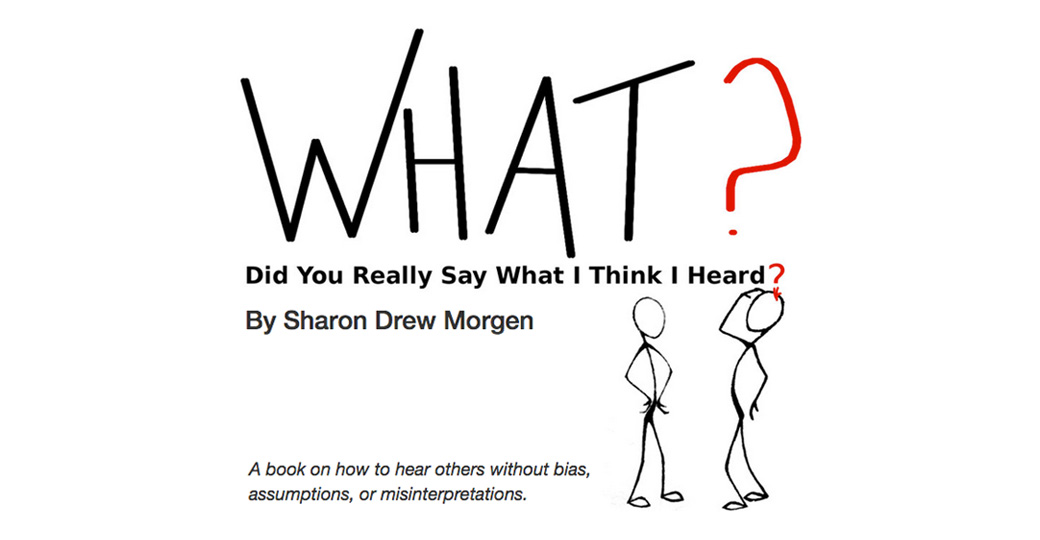Solving a Problem is Systemic: avoiding resistance and ensuring permanent change is more complex than changing behaviors, by Sharon-Drew Morgen
 Problems are incongruent behaviors that have arisen from the system that triggered them. To solve problems permanently and without resistance it’s necessary to take corrective measures at the source, in the neural circuits where the problem was initiated. Unfortunately, we attempt to solve them by trying to change the incongruent behavior.
Problems are incongruent behaviors that have arisen from the system that triggered them. To solve problems permanently and without resistance it’s necessary to take corrective measures at the source, in the neural circuits where the problem was initiated. Unfortunately, we attempt to solve them by trying to change the incongruent behavior.
Until now, behavior change has been the preferred approach to problem solving. Folks trying to effect change in others – coaches, leaders, managers, sellers, docs – pose the ‘right’ questions and listen attentively to better understand the problem, assuming once they understand they’ll lead the Other to their answers.
But questions aren’t what they seem, and brains cause deficient listening, causing a fail rate for behavior change at over 90%:
- Questions: Standard questions are biased by the words, phrasing, goals, assumptions, and needs of the Asker. As such they may not obtain ‘good’ or complete information. This problem is compounded by brains that can’t ‘listen’, making it likely that neither Speaker or Listener accurately understand each other.
- Listening: Sadly, there’s only a 10-35% chance we accurately hear each other. The way brains listen is filled with distortions and deletions causing misunderstandings, mistranslations, and false assumptions. (My book WHAT? explains this). I know we all assume that listeners accurately hear what we say. They cannot, even when we attempt to speak in ways we’ll get heard.
- Curiosity/understanding: We can only be curious about what we notice or think – both of which are restricted by what we already know. All that we think, hear, see, feel, know is triggered from neural circuits in our brain. There’s no way to notice anything unless it’s already there, making it impossible to be curious about anything that our brains don’t recognize. In other words, even our curiosity is biased.
- Risk: for some reason, influencers and change agents forget to factor in risk. If the risk of change is greater than the risk of staying the same, no change will take place. Obviously an outsider can never understand another person’s risk.
Since the data we gather is potentially biased by our questions and restricted to what Askers think they need to understand; and what we each hear is potentially inaccurate due to the way brains listen; there’s a high probability that information collected will be biased, insufficient, inaccurate and will lead to potentially flawed suggestions.
ELEMENTS IN PROBLEM SOLVING
Decades ago, when I begin my career, I couldn’t understand why permanent change was so difficult. Surely, with accurate, rational reasons, behaviors should change. But they didn’t. Trying a different approach I began studying brains: where decisions get made within the brain’s neural circuitry; and the interplay between the unconscious electrochemical brain and the conscious, action-oriented mind.
What I discovered goes against standard practice: to generate new, permanent behavior, change must originate at the source, in the neural circuits that triggered the original, problematic behaviors so they can generate new ones. I’ve since developed Change Facilitation models for several industries, trained 100,000 people and written extensively.
Below I offer a primer to my thinking, ideas and skills for those coaches, System Dynamics practitioners, Change Management consultants, OD professionals and leaders willing to work beyond the standard change models to lead clients through to permanent, integrous change – without resistance, and with buy-in.
I’ll begin with the fundamental question: when helping Others make needed changes, why do we need to understand anything? The actual task of facilitating permanent change is a neural circuit/systems issue within the Other’s brain before it’s an understanding or comprehension issue for an influencer.
While the specific act of understanding is a What/Why, change itself is a How issue – How to get to the specific neural circuits where the change is implemented: What/Why is tactical; How is systemic and strategic.
Too often influencers assume their important advice will lead to permanent change and omit this important element. Without knowing how to get to the originating source where the problem was triggered, a client can’t implement the guidance and it will be resisted.
Different from information gathering or understanding the story and details of a problem, the skills needed to enable clients to get to specific circuits and make necessary changes is a How, and precedes What/Why. Here are the elements involved:
- All activity, all behaviors – all that we see, hear, do, think – emerge from neural circuits in our brains that are formed by systems. Any change must include new or reconfigured circuits so new choices will be triggered at the source.
- A behavior is merely the expression, the representation, of the system that triggered it. For permanent behavior change, the originating system and the circuits trigger different behaviors.
- Our brains have 100+trillion neural pathways, each one expressing a unique system, each one triggering specific activity and behaviors. These are where all behaviors and decisions emerge from and which send signals to the mind to take the action.
- Change must not put the system at risk or it will be rejected, made possible when the change emerges directly from the neural circuits.
Current behavior change models focus on the influencer understanding the problem then leading the client to change via the influencer’s assumptions rather than enabling clients to discover their own, and is responsible for the low success rate (97% by some estimates). Turns out this is a systems problem: to better understand change it’s necessary to understand the role systems play in creating a new solution.
SYSTEMS
A system is any group of ‘things’ that agree to the same rules, beliefs, values. You’re a system. Your family is a system. Each country has a system. They are the bedrock of all cultures and create/maintain the status quo, with behaviors the expression. Here are some facts about systems that must be incorporated into any change process:
- A solution must embody the underlying system that has dispatched the offending behaviors. The system itself must be changed so it emits different behaviors. Change the system and new behaviors emerge. Gathering data and providing answers does not change a system, merely gets mistranslated and seen as a risk.
- The rules of the system must be maintained in any change, or it will be resisted. The rules of the system define the solution. For change, help Others discover the rules, norms, beliefs of their system.
- It’s not possible to change a behavior by trying to change a behavior. Behaviors are the expressions, the physical output of a system and as such are meaningless on their own; they don’t arise from the sea like Venus.
- Problems are features, not flaws. Because the ‘problematic’ actions are merely expressions of the underlying system, whatever shows up has been triggered by the system it’s expressing. Again, providing ‘good’ information will not change a system.
- Change must come from, and follow the norms/rules of, the circuits that initiated the perceived problem.
- When influencers try to merely change behaviors, they’re working from their own biased assumptions and potentially discounting the norms and rules of the system. This causes resistance, sabotage and opposition.
- If the risk of change is greater than the risk of staying the same, no change will occur. The job of the influencer is to help clients understand their risk of change, and all stakeholders must have a say in any proposed change or they will resist at the point of implementation.
- Implementation and execution will be problematic unless
a. All stakeholders who will be involved in the bought into the change;
b. The risk of change is acceptable to the stakeholders;
c. The rules of the system have been maintained.
Without addressing these points, any attempts at change are driven by the biases of the practitioner and may miss the underlying system that generated them. This is especially relevant for System Dynamics, Change Management, Coaching, Leadership, Management, Healthcare, and Sales.
To enable permanent change requires wholly new thinking and new skills based on facilitating folks to the original circuits that expressed the problematic behavior so they can make their own change. No information gathering. No guidelines for change. Just impartial skills that lead Others to the specific neural circuits where the problem was initiated. This includes: Facilitative Questions™, Meta Listening, the 13 Steps of Change. And the biggest one of all: assuming Others have their own answers instead of trying to provide them what you believe to be answers.
I’ve invented change facilitation models that facilitate change at the source and am happy to teach them to you. Visit www.sharon-drew.com to read some of my articles. sharondrew@sharondrewmorgen.com
If you had the skills to lead your clients to their own unconscious place to make their own necessary changes, would you be willing to give up the control you think you have?
_____________________________
Sharon-Drew Morgen is a breakthrough innovator and original thinker, having developed new paradigms in sales (inventor Buying Facilitation®, listening/communication (What? Did you really say what I think I heard?), change management (The How of Change™), coaching, and leadership. She is the author of several books, including her new book HOW? Generating new neural circuits for learning, behavior change and decision making, the NYTimes Business Bestseller Selling with Integrity and Dirty Little Secrets: why buyers can’t buy and sellers can’t sell). Sharon-Drew coaches and consults with companies seeking out of the box remedies for congruent, servant-leader-based change in leadership, healthcare, and sales. Her award-winning blog carries original articles with new thinking, weekly. www.sharon-drew.com, https://sharondrew1.substack.com/, and https://medium.com/@sharondrew_9898/. She can be reached at sharondrew@sharondrewmorgen.com.
Sharon Drew Morgen October 6th, 2025
Posted In: News



